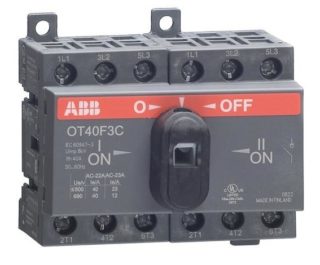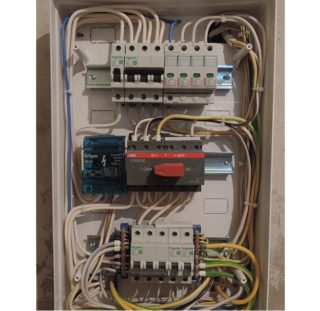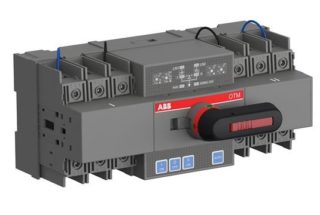If it is necessary to distribute the load on several parallel lines in a three-phase or single-phase circuit, a reversible switch is used (it is also a reversing switch or an automatic / circuit breaker). The device has a simple design, completely safe for the master at the time of its operation. You can only control the machine manually.
Definition and purpose of a reversing switch
A reversing switch is called a special switch, thanks to which the master can translate into the opposite state (invert) the switching of the conductors connected to the device.
The device is used in three-phase current circuits. When installing the switch, it is possible to evenly redistribute power to several lines without disrupting the power supply of the entire house, premises.
A reversing switch is installed on such objects:
- Private houses with powerful equipment in them: oven, hob, etc.
- Industrial enterprises in the food sector: bakeries, bakeries, confectioneries, food factories.
- Heavy industry.
- Medical institutions.
- Public places: cinemas, shopping centers, museums, etc.
Use switches wherever there is a need for the full organization of switching without failures. It is important to eliminate the likelihood of a short circuit.
Switch design
The reversing machine has the form of a box with a knife integrated contact system and spring brackets. When the first one is closed, metal blades are included in the brackets. Thanks to this principle of action, contact rupture under its own weight is excluded. There is a smooth redistribution of electricity from one line to another.
You can fix the switch on the wall in any position - horizontally, vertically and even diagonally. It does not affect its performance.
Types of knife switches
Reverse relays are classified according to several criteria - the number of poles and switching currents.
There are such types of switches:
- Unipolar. Are applied to a single-phase electric network. They have one module with a copper conductor. Most often used in residential premises. Single-phase reversing machine is ideal for generators with a frequency of not more than 20 Hz.
- Bipolar. They are most often used in apartments with ordinary and more powerful household appliances. The switch has two inputs. This means that with its help it is possible to simultaneously feed equipment from a three-phase and single-phase network. The negative resistance of such devices is 60 ohms. At the same time, the input voltage is not regulated for bipolar devices.
- Tripolar. These types of circuit breakers are operated in three-phase electric lines without a zero drive. It is permissible to use such a switch in a single-phase network, but provided that only two poles are involved.
- Four-pole. Indicated for use in the case of operation of a three-phase electric network and the same generator. The relay facilitates the smooth switching of three phases plus zero between the generator and the main power line.
By rated currents, the manufacturer offers modern consumers automatic machines with switching parameters from 16 A to 1.6 kA. Some varieties can be used in networks with voltages up to 660 V.Some - up to 440 V.
Additionally, the switches are divided into two types - with a parallel or perpendicular output, based on the location of its installation and the connection of all external terminals. There is also the opportunity to buy a device of a combined type.
If the master understands that with the power supply device there will be a need to switch the voltage on, it is better to buy a reversing relay with an arcing chamber. It contributes to the extinction of the arc and thereby prevents the failure of the apparatus.
Specifications
All reversing circuit breakers have the following main technical parameters:
- indicators for rated current - from 16 to 3,200 A;
- number of poles - from 1 to 4;
- permissible operating temperature - no more than -40 degrees to +55;
- cable section - from 0.75 to 35 mm2;
- installation type - din rail or circuit board.
Some models also have a control knob.
Device Installation
Regardless of which machine is connected, a reversing switch is single-phase for a home or two-, three-, four-phase, when installing it, you must adhere to the following rules:
- Installation of the device is carried out only in closed rooms. Do not allow moisture to get into the box of the device. If the installation is carried out outdoors, it is necessary to protect the switch with a sealed box-box. It must be locked.
- It is allowed to mount the device at temperatures from -40 to +55 degrees.
- The relay is fixed according to all the rules. Free movement of the mechanism when exposed to it is not allowed.
- If the recommended operating temperature range cannot be maintained, it is necessary to provide heating or cooling of the protective cabinet.
- The connection of a reversing switch of a three-phase, two-, one- or four-phase is carried out using a wire crimped by a sleeve, a busbar or wires with a central core.
Installation of a reversing switch according to the scheme should be carried out by an experienced electrician who has permission to perform this type of work. Otherwise, emergency situations are not excluded. Installation of the relay (reverse) is carried out only with a complete blackout of the network.
Recommendations for use
For the full operation of the changeover switch-disconnector, it is desirable to install devices in plastic boxes only in the building. For streets, it is better to provide a more durable metal box.
If burning of the upper zone of one of the contact knives is noted, they must be cleaned with a fine-abrasive file.
The rest of the reversing relay does not require special operating principles.







